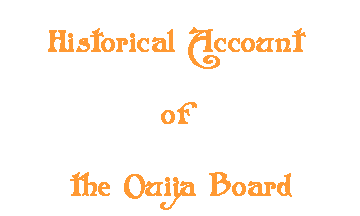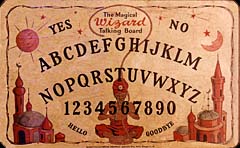
In the year 1848, something unusual happened in
Hydesville, New York. Two sisters, Kate and Margaret Fox, contacted the spirit
of a dead peddler, became instant celebrities and started a national obsession
that spread all across the United States and Europe. It was the birth of modern
Spiritualism.
Unique individuals, designated "mediums"
because they acted as intermediaries between spirits and humans, invented a
variety of interesting ways to communicate with the spirit world. Table turning
(tilting) was one of these. The medium and attending sitters would rest their
fingers lightly on a table and wait for spiritual contact. Soon the table would
tilt and move and knock on the floor in a code to represent the different
letters of the alphabet. Entire messages from the spirits could be spelled out
in this way.
Another technique was a form of spirit writing
employing a small basket with a pencil attached to one end. The medium simply
had to touch the basket, establish contact, and the spirit would take over,
writing the message from the Great Beyond. The pencil basket quickly evolved
into the more sophisticated planchette, a small heart shaped table with two
rotating casters underneath. A pencil at the apex formed the third leg.
The problem with table turning was that it took far
too long to spell out messages. Planchette writing was often difficult if not
impossible to read. Consequently, many mediums simply dispensed with it,
preferring to transmit from the spirit world mentally in an altered state of
consciousness called "trance." Others eliminated the planchette but
kept the pencil, finding the hand a more precise and less troublesome writing
instrument.
By the 1880's, the planchette was a popular parlor
game actively marketed by many US and European toy companies. Three enterprising
Americans: E.C. Reiche, Elijah Bond, and Charles Kennard came up with a concept
Borrowing from the archetype of the earlier dial plate talking boards, they
created an all new alphanumeric design. They spread the letters of the alphabet
in twin arcs across the middle of the board. Below the letters were the numbers
one to ten. In the corners were "YES" and "NO." They used a
planchette like table (shaped more like a paddle) but instead of casters, used
padded wooden pegs to permit a smooth glide over the surface of the board. All
you had to do was connect to the spirit world and let the planchette move from
letter to letter and spell out a message.
William Fuld was the father of the Ouija board.He was
the most successful Ouija manufacturer of his time, selling millions of Ouija
boards, toys and other games.
One of William Fuld's first public relations
gimmicks, as master of his new company, was to reinvent the history of the Ouija
board. He said that he himself had invented the board and that the name Ouija
was a fusion of the French word "oui" for yes, and the German "ja"
for yes. He also made other unlikely claims. Whether he took himself seriously
is a matter lost to history. In all likelihood he simply thought apocryphal
tales were a fun way to sell Ouija boards and to poke fun at a gullible press.
Almost from the beginning, William Fuld's Ouija board
suffered fierce competition from other toy makers. Everyone wanted to make a
variation of the Wonderful Talking Board. Ouija imitations flooded the market.
Some even used the Ouija name and the identical board layout. For thirty-five
years William Fuld ran the company through good times and bad. In February 1927,
he died in a tragic accident but rumor mongers eager to create a sensation
suggested that William was despondent and had actually committed suicide.
After his death, William's children took over and
developed many interesting Ouija versions of their own. In 1966, they retired
and sold the business to Parker Brothers. Parker Brothers continued to produce
an accurate Fuld replica and briefly even made a Deluxe Wooden Edition Ouija.
They own all trademarks and patents to this day. In early 1999, Parker Brothers
stopped manufacturing the classic Fuld Ouija board and switched to a smaller
less detailed glow in the dark version.
